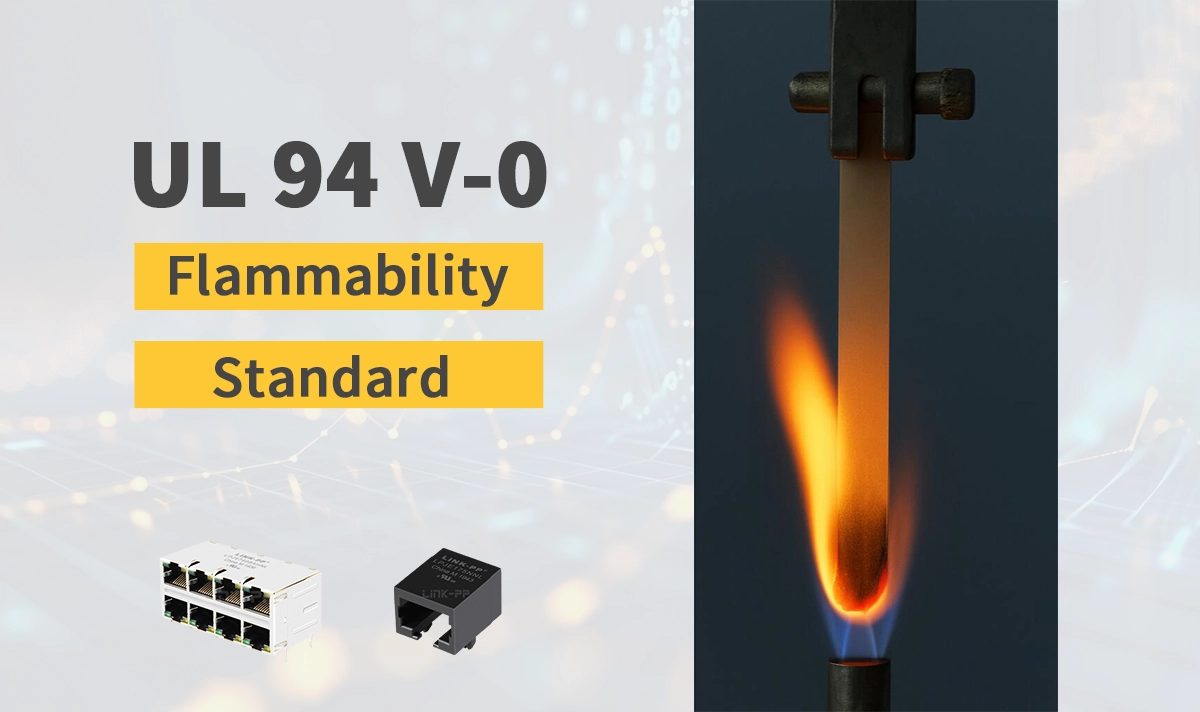
1. Introduction
UL 94 is a globally recognized flammability standard for polymeric materials, developed by Underwriters Laboratories (UL). It defines various classifications for the burning characteristics of plastics used in devices and appliances. Among these, V-0 is the most stringent vertical burn classification, indicating the highest level of flame resistance achievable under this test method.
V-0 certification is widely required in electronics, telecommunications, data center infrastructure, and other safety-critical applications.
Comparison Table of UL94 Flammability Ratings
Rating | Test Orientation | Maximum Afterflame Time | Flaming Drips Allowed | Typical Applications |
|---|---|---|---|---|
V-0 | Vertical | 10 seconds | Not allowed | Network connectors (RJ45) housings |
V-1 | Vertical | 30 seconds | Not allowed | Electronic device enclosures |
V-2 | Vertical | 30 seconds | Allowed | Consumer electronics enclosures |
HB | Horizontal | 60 seconds /100mm | N/A | Basic plastic enclosures |
Industry recommendation: For critical infrastructure and export projects, specify V-0 rating and require certification from ISO/IEC 17025 accredited laboratories.
2. Test Methodology
2.1 Specimen Preparation
Dimensions: Typically 127 mm × 12.7 mm (5 in × 0.5 in) bars.
Thickness: Tested at relevant production thicknesses.
Conditioning: Two sets of specimens are prepared: one conditioned at 23 °C and 50 % RH for 48 h, and another at elevated temperature (e.g., 70 °C) for 7 days.
Quantity: Five specimens per set, with each specimen subjected to two flame applications.
2.2 Flame Source and Application
Flame Height: Approximately 20 mm blue Bunsen burner flame.
Procedure: The flame is applied to the lower end of the vertically mounted specimen for 10 seconds; after flaming ceases, it is applied again for another 10 seconds.
3. Acceptance Criteria for V-0 Classification
A material achieves the V-0 rating if it meets all of the following:
Self-Extinguishing
After each 10-second flame application, flaming combustion must cease within 10 seconds.Total Flaming Time Limit
Across all 10 flame applications (five specimens × two applications each), the total flaming time must not exceed 50 seconds.No Flaming Drips
Burning material must not drip and ignite the dry absorbent cotton indicator placed 300 mm below the specimen. Drips are permitted only if non-flaming and do not ignite the cotton.Clamp Safety
Flames or glowing combustion must not propagate up to the holding clamp.Afterglow Restriction
After the second flame application, glowing combustion must not exceed 30 seconds.
4. Importance in Industry
4.1 Safety Compliance
V-0 materials significantly reduce fire risk in electronic enclosures, connectors, and other polymer components, ensuring compliance with stringent safety regulations.
4.2 Procurement & Specifications
Typical Applications: RJ45 connectors housings, switch and router enclosures, industrial control panels.
Common Requirement: Many North American, European, and international public-sector tenders stipulate V-0 compliance, often requiring third-party certification from ISO/IEC 17025-accredited laboratories (UL, TÜV, SGS, etc.).
4.3 Related Standards
RoHS (Restriction of Hazardous Substances) — limits hazardous materials in electrical/electronic products.
IEC 60695 — series of fire hazard testing standards.
Halogen-free requirements for reduced toxicity and environmental impact.
4.4 Case Study: LINK-PP’s UL94 V-0 Certified Network Solutions
As a global leader in RJ45 magnetic connectors and LAN transformers, LINK-PP offers a range of products certified to UL94 V-0:
LINK-PP LAN Transformer: Enclosure made of thermoset plastic material with flame retardant rating UL 94V-0 or better.
LINK-PP RJ45 Connector: Housing made of PBT black thermoplastic material, compliant with UL94 V-0 flame retardant standard.
These components are widely used in:
Data center switches and servers
Telecommunications room routers and access devices
Industrial automation network nodes
5. Common Misconceptions
“All plastic parts must be V-0” — Not necessarily. Only those in proximity to electrical circuits or high-risk areas are typically required to meet V-0.
“V-0 is the same as V-1/V-2” — Incorrect; V-0 has more stringent limits on afterflame time and dripping.
“Whole device certification” — UL 94 ratings are usually for specific materials/components, not complete assemblies.
6. Conclusion
The UL 94 V-0 classification is a critical benchmark for fire safety in plastics used in electrical and electronic products. Understanding the exact test procedures and acceptance criteria is essential for engineers, compliance officers, and procurement specialists to ensure both product safety and regulatory conformity.
For procurement or design purposes:
Always request official V-0 test reports from accredited labs.
Specify exact test thickness and relevant conditions in contracts.
Review related compliance requirements to meet all market-entry standards.
By adhering to these principles, manufacturers and suppliers like LINK-PP can achieve safer products, greater market access, and stronger customer trust.




